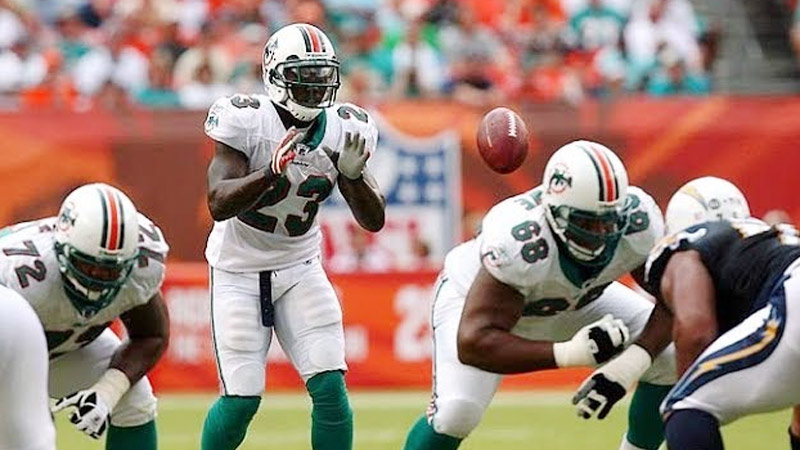When it comes to the dynamic and ever-evolving world of football strategy, coaches and players are continually seeking innovative ways to outwit their opponents.
Among the many tactical tools in a team’s playbook, the Wildcat formation has emerged as a fascinating and effective approach.
In this blog post, we’ll delve into the intricacies of the Football Wildcat Formation—unraveling its mysteries, understanding its pros and cons, and exploring its impact on the game.
Whether you’re a die-hard football enthusiast or simply curious about how teams shake up their offensive strategies, read on to discover what makes the Wildcat formation an intriguing addition to the playbook. Stay focused.
What Is a Football Wildcat Formation?
A Wildcat formation in football refers to a strategic offensive formation where the traditional structure is altered by snapping the ball directly to a player who is not the designated quarterback.
In this setup, a player from a different position, often a running back or wide receiver, lines up in the quarterback’s usual position behind the center. This approach is designed to catch the defense off guard, creating unique opportunities for running, passing, or trick plays.
The Wildcat formation aims to exploit the element of surprise and capitalize on the skill set of the player receiving the snap. Since this player might be more versatile in terms of running, throwing, or both, it introduces a level of unpredictability into the offensive scheme.
This unpredictability can confuse the defensive players who are accustomed to reacting to traditional quarterback-centric plays. The primary advantage of the Wildcat formation is its potential to gain significant yardage by utilizing the ball carrier’s skills and quick decision-making.
Roles of the Players in Football Wildcat Formation
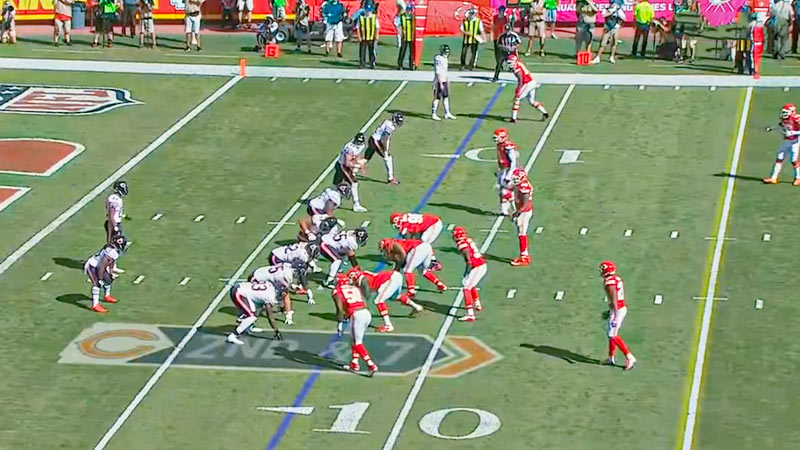
In a football Wildcat formation, the roles of the players are redefined compared to traditional offensive formations. The unique aspect of the Wildcat is that the ball is snapped to a player other than the quarterback.
This player, often a running back or wide receiver, assumes a dual role of a ball carrier and a potential passer. Here are the key roles of the players in a typical Wildcat formation:
Wildcat Quarterback (Non-Traditional)
This player, usually a running back or wide receiver, lines up in the quarterback position. They receive the snap directly from the center and have the responsibility of making quick decisions based on the defense’s alignment.
Their dual-threat ability is crucial; they must be capable of running the ball effectively, making snap decisions, and occasionally throwing accurate passes if the defense is caught off guard.
Running Backs
The running backs in the Wildcat formation play a significant role. One of them typically lines up alongside the Wildcat quarterback in the backfield.
This running back can receive handoffs from the Wildcat quarterback, execute misdirection plays, or even act as a potential pitch option. Running backs in the Wildcat need to have strong ball-carrying skills and vision to exploit gaps in the defense.
Offensive Line
The offensive line maintains its traditional role of protecting the ball carrier and creating running lanes. They block for the Wildcat quarterback and other ball carriers as they execute runs or handoffs.
The offensive linemen must adjust their blocking schemes based on the specific play called in the Wildcat formation.
Wide Receivers
Wide receivers in the Wildcat formation need to be versatile. They might be used as potential ball carriers on end-around plays or reverses.
Additionally, some Wildcat plays involve wide receivers as pass options, allowing them to throw the ball downfield if the defense fails to cover them properly.
Tight Ends
Tight ends might also be integrated into the Wildcat formation. They can serve as blockers to open up running lanes or as additional pass-catching options if the play involves a passing element.
When to Use Football Wildcat Formation?
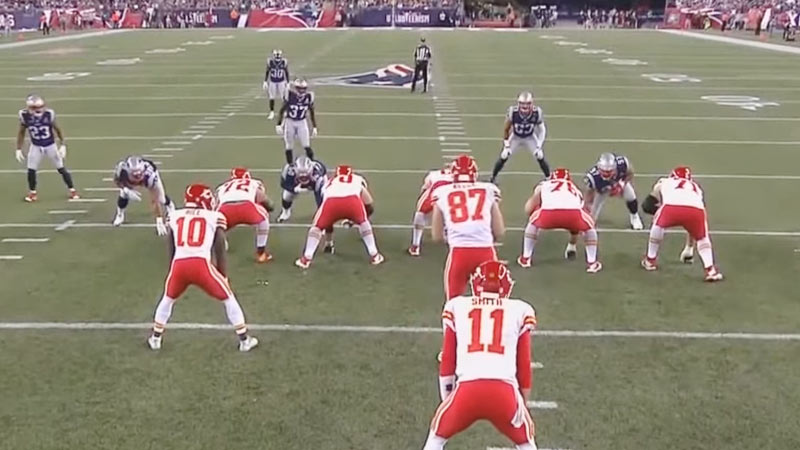
The football Wildcat formation can be strategically employed in various situations to create confusion, exploit defensive weaknesses, and gain an advantage over the opposing team.
Here are some scenarios when teams might choose to use the Wildcat formation:
Change of Pace
Coaches often use the Wildcat formation as a change of pace from the team’s regular offensive plays. By suddenly shifting to the Wildcat, the defense is forced to adjust quickly to a different set of plays and potential ball carriers. This change of rhythm can catch the defense off guard.
Short Yardage Situations
In situations where a team needs to gain a few yards to convert a crucial third or fourth down, the Wildcat can be effective.
The direct snap to a ball carrier allows for quicker penetration of the line of scrimmage, potentially gaining the necessary yardage without relying on traditional quarterback-center exchanges.
Red Zone and Goal-Line Plays
The Wildcat can be advantageous in the red zone and near the goal line. The direct snap and potential for quick running plays can create a compact and dynamic offensive attack that is difficult for the defense to defend against in tight spaces.
Exploiting Defensive Alignment
If the defense is showing vulnerabilities against the run or is struggling to contain certain types of plays, the Wildcat can be used to exploit these weaknesses. The versatility of the Wildcat quarterback and the direct snap can capitalize on gaps in the defensive line.
Setting Up Trick Plays
The Wildcat formation can serve as a setup for trick plays. The element of surprise makes it a good platform for reverses, end-around, and even gadget plays like double passes, where the Wildcat quarterback becomes a potential passer.
Time of Possession and Clock Management
Utilizing the Wildcat formation can help a team control the clock and maintain possession of the ball. By executing run-heavy plays and extending drives, the offense can limit the opposing team’s opportunities to score.
Against Aggressive Pass Rush
If the opposing defense is known for aggressive pass rushing, the Wildcat can be used to minimize the impact of pass rushers. The quick, direct snap to a ball carrier can neutralize the pass rush and create opportunities for successful runs.
Exploiting Defensive Strategy
If the defense focuses heavily on the traditional quarterback, using the Wildcat can force the defense to shift their attention and adapt to the new offensive threat. This adjustment might open up other areas of the field for exploitation.
Strategies of Football Wildcat Formation
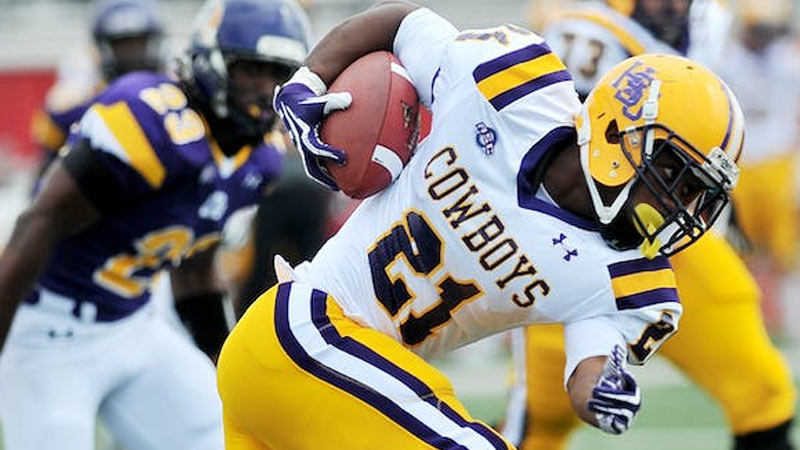
Using the football Wildcat formation effectively involves implementing specific strategies that maximize its potential for success. Here are some key strategies to consider when utilizing the Wildcat formation:
Versatile Ball Carrier Selection
Choose a player to act as the Wildcat quarterback who possesses a diverse skill set. This player should be a capable runner, have good decision-making abilities, and potentially possess the ability to throw accurate passes.
A running back or wide receiver with a history of successful ball carrying and quick thinking is ideal.
Pre-Snap Reads and Audibles
Just like a traditional quarterback, the Wildcat quarterback should have the authority to make pre-snap reads and audibles based on the defensive alignment. If the defense shows a particular vulnerability, the Wildcat quarterback can adjust the play accordingly to exploit it.
Creative Play Designs
Develop a playbook that includes a variety of plays tailored to the strengths of the players in the Wildcat formation. Incorporate a mix of run plays, misdirections, pitches, and even pass plays to keep the defense guessing. Trick plays and unexpected variations can add an element of surprise.
Quick Decision-Making
Emphasize quick decision-making by the Wildcat quarterback. Since the ball carrier receives the snap directly, they must read the defense’s movements and react promptly to either run, handoff, or pass. This speed and decisiveness can catch the defense off guard.
Blocking Adjustments
Design blocking schemes that suit the Wildcat plays. Offensive linemen and other blockers must adjust their blocking assignments based on the play call. Effective blocking at the point of attack is crucial for creating running lanes and protecting the ball carrier.
Utilize Motion and Shifts
Incorporate pre-snap motion and shifts to create confusion among the defensive players. Shifting formations and motioning players can cause the defense to adjust its alignment, potentially creating mismatches or gaps that the Wildcat quarterback can exploit.
Dual-Threat Option
Showcase the dual-threat capabilities of the Wildcat quarterback. By threatening both the run and the pass, the defense has to respect both options, making it harder to predict the play’s outcome.
Maintain Balance with Traditional Offense
While the Wildcat formation can be a powerful tool, it’s essential to maintain a balanced offensive approach. Mixing Wildcat plays with traditional passing plays involving the primary quarterback prevents the defense from focusing solely on stopping the Wildcat.
Surprise Timing
Deploy the Wildcat formation strategically at unexpected moments during the game. Timing is crucial—using it when the defense is least prepared can lead to significant gains and positive outcomes.
Practice and Repetition
Regularly practice Wildcat plays during team practices to ensure that players are comfortable with the formations, assignments, and execution. Repetition helps build confidence and precision in executing the plays effectively.
Pros of Football Wildcat Formation

The football Wildcat formation offers several advantages that coaches and teams can leverage to gain a competitive edge on the field. Here are some of the key pros of using the Wildcat formation:
Surprise Factor
One of the most significant advantages of the Wildcat formation is its element of surprise. By snapping the ball directly to a player other than the quarterback, the defense is caught off guard, increasing the likelihood of successful plays. This surprise factor can lead to big gains and touchdowns.
Exploiting Defensive Mismatches
The Wildcat formation allows teams to exploit defensive weaknesses and mismatches. By design, it creates opportunities for skillful ball carriers to face defenders who might not be as adept at tackling or covering different positions, leading to potential mismatches in speed and agility.
Running Threat
The direct snap to a running back or versatile player increases the potential for successful rushing plays. Ball carriers can quickly identify gaps in the defense and exploit them, leading to significant yardage gains and consistent ground attacks.
Dual-Threat Options
The Wildcat quarterback, often a running back or wide receiver, becomes a dual-threat player capable of both running and passing. This versatility forces the defense to respect both options, making it challenging to predict the play’s outcome.
Reduced Turnover Risk
With fewer traditional quarterback-center exchanges, the Wildcat formation can reduce the risk of fumbles that might occur during snap exchanges. The direct snap to the ball carrier eliminates this potential source of turnovers.
Time of Possession
The Wildcat formation’s emphasis on running plays can help control the clock and maintain possession of the ball. By executing successful rushing plays and sustaining long drives, the offense limits the opposing team’s offensive opportunities.
Goal-Line and Short-Yardage Plays
The compact nature of the Wildcat formation makes it effective near the goal line and in short-yardage situations. The direct snap can create a quick burst of momentum, making it easier to punch the ball into the end zone or convert critical third and fourth downs.
Unpredictability
The Wildcat formation’s varied play options make it challenging for defenses to anticipate the next move. This unpredictability can force defenders to hesitate or make incorrect reads, creating opportunities for the offense to exploit.
Play Action and Trick Plays
The Wildcat formation can serve as a platform for creative play action and trick plays. The potential for the Wildcat quarterback to run, pass, or execute reverses can set up unexpected plays that catch the defense out of position.
Confusion and Defensive Adjustments
The unique formation and the need for the defense to adjust to the unconventional play style can cause confusion and disrupt defensive strategies. This can open up opportunities for the offense to capitalize on breakdowns in the defense’s alignment.
Cons of Football Wildcat Formation
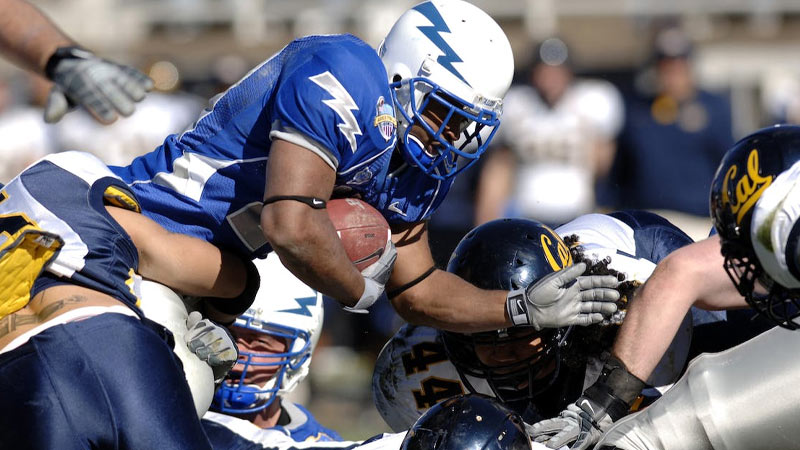
While the football Wildcat formation offers several advantages, it also comes with certain drawbacks and challenges that coaches and teams need to consider. Here are some of the key cons of using the Wildcat formation:
Limited Passing Threat
One of the primary drawbacks of the Wildcat formation is the reduced passing threat. Since the designated Wildcat quarterback is often not a natural passer, defenses can focus more on stopping the run without the same level of concern for a deep passing threat.
Predictability
Over time, defenses may become more familiar with the Wildcat formation and the types of plays it entails. This predictability can lead to defenders keying in on certain tendencies, making it harder to consistently gain yards and first downs.
Defensive Adjustments
While the Wildcat formation aims to force defensive adjustments, experienced defensive coordinators can quickly adapt by implementing strategies to contain the run and minimize the formation’s impact. This could limit the formation’s effectiveness over the course of a game.
Pass Rush Impact
With a non-traditional quarterback taking the snap, the Wildcat formation can be vulnerable to aggressive pass rushes. Defenses may focus on pressuring the Wildcat quarterback to disrupt plays and force quick decisions, potentially leading to negative plays.
Reduced Flexibility
The Wildcat formation is specialized and might not suit all game situations. Teams that heavily rely on passing or have a less mobile player in the Wildcat quarterback role might find it challenging to execute effectively.
Lack of Downfield Threat
Defenses can adjust their coverage to account for the lack of a deep passing threat, making it harder to generate big plays downfield. This limitation can impact a team’s ability to score quickly in comeback situations.
Injury Risk
The Wildcat quarterback, who often takes direct snaps and engages in physical running plays, could face an increased risk of injuries. Running backs and wide receivers may not have the same level of protection as traditional quarterbacks, making them more susceptible to hits.
Complex Execution
Successfully executing the Wildcat formation requires precise timing, quick decision-making, and strong communication among the offensive players. Any breakdown in execution can lead to negative plays or turnovers.
FAQs
What is the Football Wildcat Formation?
The Football Wildcat Formation is an offensive strategy where the ball is snapped directly to a player other than the traditional quarterback.
Typically, a running back or wide receiver lines up in the quarterback position and becomes a dual-threat player, capable of running, passing, or even executing trick plays.
When is the Wildcat Formation Used?
Coaches employ the Wildcat formation strategically in various scenarios. It’s often used as a change of pace to catch the defense off guard, in short-yardage situations, near the goal line, and to exploit defensive mismatches or vulnerabilities.
What are the Pros and Cons of the Wildcat Formation?
The Wildcat formation offers advantages such as surprise, exploiting mismatches, versatile running threats, and reduced turnover risk. However, it also comes with limitations, including a limited passing threat, predictability, and the potential for defensive adjustments.
How Does the Wildcat Formation Affect Defensive Strategies?
The Wildcat formation forces defenses to adjust their strategies to account for unconventional plays and the dual-threat capabilities of the Wildcat quarterback. It can create confusion, impact defensive alignments, and require quick adaptations on the field.
How Can Teams Maximize the Effectiveness of the Wildcat Formation?
To make the most of the Wildcat formation, teams should focus on player versatility, quick decision-making, creative play designs, and balancing the formation with traditional offensive plays. Effective execution, practice, and adaptability are key components of success.
Wrapping Up
As football continues to evolve, so too do the strategies employed by teams seeking a competitive edge. The Football Wildcat Formation stands as a testament to the creativity and innovation that coaches bring out.
By disrupting the traditional quarterback-centric approach, the Wildcat formation injects unpredictability, excitement, and strategic depth into the playbook.
Whether it’s a quick run, a daring pass, or a trick play that catches everyone off guard, the Wildcat formation showcases the dynamic nature of football strategy—a sport where innovation and adaptability reign supreme. Best of luck.

